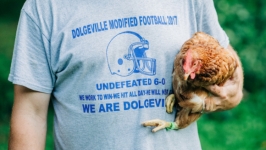Save Your Fennel Seeds
Is there anything more impressive than a seed? As a longtime seed enthusiast, it’s easy for me to get hyperbolic when talking about the genius held within these sometimes miniscule, sometimes massive vessels. Containing both the genetic information and the nutrients necessary to start new life, seeds are a reminder of the brilliance of the natural world.
Perfectly designed to store, travel, fly or stick. Attuned to their often hyper-specific environments. Working in tandem with animals, humans, plants and microorganisms. Seeds have seriously figured it out.
That innovation and resourcefulness all centers around giving each plant species the best chance at survival, so the fact that seeds are often delicious is no accident. Being eaten is simply part of a seed’s plan. From tiny chickadees to lumbering black bears, our surrounding forests are full of hungry seed transporters and germinators, unintentionally working for plant-life as they enjoy a late-summer or autumn snack. Our own diverse, omnivorous diets include a long list of seeds cultivated specifically for their use in the kitchen. Grass seeds and legume seeds are particularly prolific staples of diets all around the world, with corn, wheat, rice and beans serving as the caloric foundation for countless cultures throughout the course of human history.
But in our home gardens, where we aren’t frequently growing the grain and beans that make up the bulk of our meals, edible seeds often go ignored in respect to their culinary potential.
Standard garden offerings such as squash, celery and mustard greens produce often-overlooked edible seeds that could add nutritious and flavorful value to our plates. In herb and flower gardens, seeds from late-season dill, cilantro (or coriander), lovage, sweet cicely, sunflower and nasturtium plants tend to get turned back into the soil, thrown onto a compost pile, or carried away by animals and the wind at the end of a long and fruitful growing season.
I have many favorites among the edible seed-producing herbs and vegetables that grow in my northern region, and high on that list sits the versatile, beautiful and sometimes divisive plant—fennel.
Fennel, which can be grown in both bulb or non-bulb varieties, is a hearty crop even in some of the coldest northern climates. It is useful as both a vegetable centerpiece and as an herbal seasoning, and can be eaten both cooked and raw. Fennel is also one of those marvelous plants that provide us with an edible part at every stage of growth, including its last gift to the harvest season: the fennel seed.
Each part of the fennel plant, including the seed, carries with it a licorice flavor, and I find that people either love that flavor or want absolutely nothing to do with it. I fall firmly into the former camp and tend to believe that even the most devout of fennel-haters can be converted with the right recipe. (Hint: The right recipe often involves caramelization.)
Chopped raw fennel bulbs pair beautifully with goat cheese and make a crisp and flavorful addition to salads. Caramelized sliced fennel bulb is a perfect addition to a hot pasta with Kalamata olives and tomatoes, as the caramelization process highlights the vegetable’s sweetness while cutting that licorice-y bite. Sautéed fennel stalks are wonderful as part of a vegetable medley. The flower umbels (the umbrella-like flower clusters) are both beautiful and tasty as an edible garnish in food and drinks.
And finally, at the close of the season, perched at the end of the drying-out flower stalks, we find the fennel seed.
A perfect little bite of flavor, fennel seeds can be harvested once the flowers have begun to dry out and turn brown, but before the seeds begin to drop off the plant. Clip off entire flower stalks and put them, seed-side down, into a paper or cloth bag. Hang the bag in a cool, dry location for a couple of weeks until the seed-heads dry out completely. The seeds can then be fully removed by shaking the stalks inside the bag or by rubbing the seeds from the stalks over a cloth. Leave any dirt or bits of dried flowers that remain. If the seeds don’t seem completely dried out, lay them out in a single layer on a cloth for a few days or put them in a dehydrator set on low for a few hours. The seeds can then be stored in an airtight jar for up to one year.
Fennel seeds are a delicious addition to homemade tomato sauces, make a lovely warming tea, and are a perfect complement to a variety of spice mixes. In my kitchen I add fennel seeds into a Northeastern take on that classic French herb mix, herbes de Provence, by combining dried lavender, oregano, thyme, rosemary and sage with dried fennel seeds. Fragrant and flavorful, the mix is perfect on roasted meat, poultry and root vegetables, in fresh-baked breads or sprinkled on homemade pizza.
Harvested fennel seeds can also be saved and replanted, bringing with them another bountiful year full of bulbs, fronds, flowers and seeds for your culinary enjoyment. But even if you forget to save some seeds for replanting, nature will likely do the job for you, having already dropped some of the information packed parcels onto the ground. After all, seeds are nothing if not determined.
*For a lovely and informative appreciation of seeds, see the children’s book A Seed is Sleepy, by Dianna Hutts Aston and Sylvia Long. This beautifully written and meticulously illustrated book is my favorite resource when teaching both young people and adults alike about the seed cycle.







